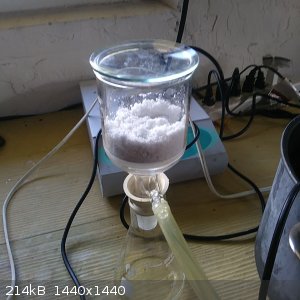
VSEPR_VOID - 15-10-2018 at 15:36
Gallium Sulfate Preparation
~34 grams of wet gallium was covered with 60 grams of drain cleaner sulfuric acid. Upon the addition, no visible reaction was observed. Upon heating
to simmering, and eventually a smooth boil, the gallium was seen to bubble significantly and a white cloudy material was seen appearing in the beaker.
As the heating was continued, the boiling stopped and the mixture became thick with white material. At this point another 30 mL of water and 30 mL of
acid was added. The boiling was continued. The solution became darker, as is common when boiling hardware store acid, so 30 mL of 3% peroxide was
added. The solution became much clearer and off white.
When 90% of the gallium was dissolved, the solution was left to cool to room temperature. At this point small white crystals formed and settled at the
bottom. These crystals, and the solution, were filtered by vacuum and washed with 100 mL of dry alcohol; after which it was left to dry under vacuum
for 24 hours.
the final product was an of white material, composed of very fine crystals that were nearly free flowing.
Special note: When heated, the crystals turned slightly darker, but when washed again with dry ISPA reverted back to their original state. This is
likely contamination from the dirty sulfuric acid.
So, what should I try and do with this stuff? Any ideas?

12thealchemist - 16-10-2018 at 04:09
Chemically, gallium and aluminium are very similar. About the only thing I can think to do with gallium sulphate is making the corresponding alum,
which has already been done on this forum by several people, myself included. Aluminium sulphate isn't a fantastically useful substance as it is, as
far as I can tell. It can be used as a mordant, so maybe you could see if gallium sulphate also works in this way? Albeit as a very expensive mordant.

VSEPR_VOID - 16-10-2018 at 05:27
Gallium does forum alums. They have been reported to be formed by the crystallization of an acidified solution of gallium and ammonium sulfate.
More interestingly, gallium salts precipitate the hydroxide when mixed with aqu. ammonia. This hydroxide when heated to 100 C formes gallium
oxyhydroxide. In addition, gallium hydroxide also forms gallates when dissolved in alkali solutions; for example when dissolved in sodium hydroxide.
I wonder if a copper gallium double salt could be produced in a displacement reaction with sodium gallate. I imagine that mixing a solution of cupric
chloride and sodium gallate might do the job. Cooling the solution should precipitate the product.
Some double salts of gallium have been prepared, including those of samarium, however I can not find a protocol for their preparation.
VSEPR_VOID - 16-10-2018 at 09:25
No reaction from gallium sulfate solution and ammonia. Next up is dilute sodium hydroxide and gallium sulfate.
Tdep - 16-10-2018 at 19:45
I'd be interested in seeing its reaction with aluminium. Gallium forms an amalgam with aluminium that allows the reaction of the bare aluminium with
water, as everyone knows, its a common reaction.
But a dilute aqueous solution of gallium sulfate: the aluminium would displace the gallium out of solution, then the bare aluminium would react with
the water until it was consumed. This would be useful in reduction reactions.
Not sure if it will work like this though. Try adding just some Al foil to a very dilute gallium sulfate solution
VSEPR_VOID - 17-10-2018 at 17:24
I will try that. I was thinking about doing something like that to make aluminium isoproxide without using any mercury (which I fear).
Edit
No reaction from aluminium powder and gallium sulfate solution, even after heating.
No reaction from gallium sulfate and 10% ammonia, even after heating
[Edited on 18-10-2018 by VSEPR_VOID]
AJKOER - 18-10-2018 at 14:28
Here is a suggested path to make aluminium isoproxide without using any mercury, basically follow a cited path (see Wikipedia, https://en.wikipedia.org/wiki/Aluminium_isopropoxide#Referen... ):
2 Al + 6 iPrOH → 2 Al(O-i-Pr)3 + 3 H2 (g)
However, I would suggest to first treat the Al metal with either NaOH and HCl. As I discussed previously (see my comments on •H at http://www.sciencemadness.org/talk/viewthread.php?tid=40137#... ), this may imbue the surface of the Al with the hydrogen atom radical (•H).
Target reaction to possibly accelerate product formation:
•H + iPrOH ---> •O-i-Pr + H2 (g) (see related Eq (6) at Buxton work at https://pdfs.semanticscholar.org/d696/b35956e38351dd2eae6706... )
Al --> Al3+ + 3 e-
•O-i-Pr + e- --> O-i-Pr-
Net:
Al + 3 •H +3 iPrOH --> Al(O-i-P)3 + 3 H2 (g)
I would expect the above reaction system to have a higher reaction rate and, upon collecting evolved hydrogen over water, twice the volume of
generated H2 per mole of consumed Aluminum compared to the Wikipedia cited equation.
[Edited on 19-10-2018 by AJKOER]
VSEPR_VOID - 18-10-2018 at 16:23
The problem with using gallium to expose from aluminium surface area is that you need a lot of gallium for every gram of aluminium. The alloy forms
very slow and is mp increases with aluminium % by weight. Non the less, its worth a shot. I know that most people do not want to deal with mercury
salts.
What are the chances of gallium isoproxide forming?
Also why is vacuum distillation needed? I do not have any vacuum grease.
[Edited on 19-10-2018 by VSEPR_VOID]

